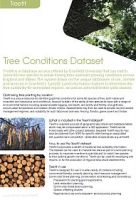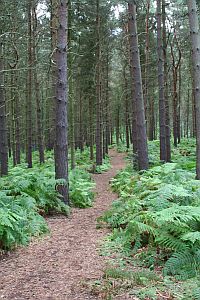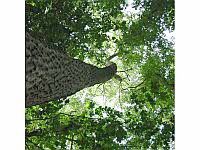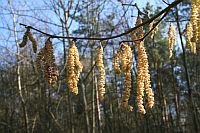
Treefit
What is Treefit?
Tree Conditions Dataset

Treefit is a database service offered by Cranfield University that can match some 60 tree species to areas having their optimum growing conditions across England and Wales. The system draws on the unique databases of soil, climate and landuse in Cranfield's Land Information System to determine the tree suitability for nominated regions, as well as potential timber yield classes.
Download the Treefit Brochure.
Optimising tree planting by location
Treefit is a unique resource for identifying optimal conditions for some 60 species of tree, both native and imported, and deciduous and coniferous. Account is taken of the ability of tree species to cope with a range of environmental factors including seasonal water-logging, soil depth, soil acidity and fertility, droughtiness, accumulated temperature and related climatic criteria. Assessments may then be used to provide recommended management regimes, and suitability for such factors as biomass, fencing, floristry, game covert and timber.
What is included in the Treefit dataset?
Treefit is supplied as a set of geographically-referenced database tables which may be incorporated within a GIS application. Treefit can therefore be linked easily with other project datasets.
Treefit reports

An alternative to leasing the underlying Treefit GIS datasets is to obtain a site-specific Treefit report from us in 'pdf' format. Individual Treefit reports may be obtained from Cranfield University for specific sites having an associated site questionnaire completed. Please contact us below for costs of this service.
How to use the Treefit dataset
Treefit incorporates a wealth of locational tree suitability information. The dataset can be used to characterise sites as part of a land planning process, to maximise investment potential and to match tree species to their optimal growth conditions. Treefit can be used for developing site reports, or for the production of regional silvicultural assessments.
TopWhat trees species are assessed?
Tree species reported by Treefit

The following tree species are included in the Treefit model output:
Noble Fir (Abies procera)
Field Maple (Acer campestre)
Norway Maple (Acer platanoides)
Sycamore (Acer pseudoplatanus)
Horse Chestnut (Aesculus hippocastanum)
Italian Alder (Alnus cordata)
Common Alder (Alnus glutinosa)
Grey Alder (Alnus incana)
Red Alder (Alnus rubra)
Silver Birch (Betula pendula)
Downy Birch (Betula pubescens)
Box (Buxus sempervirens)
Hornbeam (Carpinus betulus)
Sweet Chestnut (Castanea sativa)
Lawsons Cypress (Chamaecyparis lawsoniana)
Midland Hawthorn (Crataegus laevigata)
Hawthorn (Crataegus monogyna)
Eucalyptus (Eucalyptus gunnii)
Beech (Fagus sylvatica)
Ash (Fraxinus excelsior)
Holly (Ilex aquifolium)
Walnut (Juglans regia)
Hybrid Larch (Larix eurolepis)
Japanese Larch (Larix kaempferi)
Crab Apple (Malus sylvestris)
Southern Beech (Nothofagus sp.)
Norway Spruce (Picea abies)
Sitka Spruce (Picea sitchensis)
Lodgepole Pine (Pinus contorta)
Corsican Pine (Pinus nigra var. maritima)
Austrian Pine (Pinus nigra var. nigra)
Maritime Pine (Pinus pinaster)
Radiata Pine (Pinus radiata)
Scots Pine (Pinus sylvestris)
Mountain pine (Pinus unciniata)
London plane (Platanus hispanica)
Black Poplar (Populus nigra)
Aspen (Populus tremula)
Wild Cherry (Prunus avium)
Bird Cherry (Prunus padus)
Douglas Fir (Pseudotsuga menziesii)
Sessile Oak (Quercus petrea)
Pedunculate Oak (Quercus robur)
Red Oak (Quercus rubra)
False acacia (Robinia pseudoacacia)
Willow sp. (Salix sp.)
White Willow (Salix alba)
Goat Willow (Salix caprea)
Crack Willow (Salix fragilis)
Wellingtonia (Sequoiadendron giganteum)
Californian Redwood (Sequoia sempervirens)
Whitebeam (Sorbus aria)
Rowan (Mountain Ash) (Sorbus aucuparia)
Western Red Cedar (Thuja plicata)
Small Leaved Lime (Tilia cordata)
Common Lime (Tilia x europaea)
Large Leaved Lime (Tilia platyphyllos)
Western Hemlock (Tsuga heterophylla)
Wych Elm (Ulmus glabra)
 Top
Top
Who should use Treefit?

Treefit is designed for use in a wide variety of contexts including commercial forestry, amenity planning, land resource management, community forest planning, conservation volunteering and consultancy.
- preparation for planting grant applications
- land restoration planning
- community forest action planning
- carbon offsetting studies
- regional land use and ecosystem services policy planning
Obtaining Treefit
Contact details
Treefit is marketed via Cranfield University's National Soil Resources Institute. For further details concerning Treefit, please contact us:
Caroline Keay
Senior Environmental Information System Specialist
Cranfield Centre for Environmental & Agricultural Informatics
Cranfield University
Building 53a
Cranfield campus
Cranfield
MK43 0AL
Tel: (01234) 752992
Fax: (01234) 752970
nsridata@cranfield.ac.uk
Personal web page
Institute home page
